 For a supremely elegant brunch dish, you can’t do better than scrambled eggs with truffles. Wait! Did she say truffles? But yes, my friends. You may have heard that truffles cost as much per ounce as gold, but that turns out to be false. You may think they’re hard to find, but that’s also not true in these days of online ordering. Preserved truffles are fine in this quick and easy recipe. So go ahead — invite some guests and knock their socks off.
For a supremely elegant brunch dish, you can’t do better than scrambled eggs with truffles. Wait! Did she say truffles? But yes, my friends. You may have heard that truffles cost as much per ounce as gold, but that turns out to be false. You may think they’re hard to find, but that’s also not true in these days of online ordering. Preserved truffles are fine in this quick and easy recipe. So go ahead — invite some guests and knock their socks off.
Oeufs brouillés à la truffe / Scrambled eggs with truffles
 I’d been wanting to make scrambled eggs with truffles for a very long time, but when I went to my local farmers market recently in search of a truffle I couldn’t find one. Turns out they’re not in season. The season for the prized French black winter truffle begins only in mid-November, while the season for summer truffles ends in mid-September. But a shop in my neighborhood, Signorini Tartufi, sells the summer truffle preserved in a small jar for the remarkably affordable price of 15 euros for 25 grams. I used just one (the larger) of the jar’s two truffles, making the total cost of the dish for two about $10.
I’d been wanting to make scrambled eggs with truffles for a very long time, but when I went to my local farmers market recently in search of a truffle I couldn’t find one. Turns out they’re not in season. The season for the prized French black winter truffle begins only in mid-November, while the season for summer truffles ends in mid-September. But a shop in my neighborhood, Signorini Tartufi, sells the summer truffle preserved in a small jar for the remarkably affordable price of 15 euros for 25 grams. I used just one (the larger) of the jar’s two truffles, making the total cost of the dish for two about $10.
Creating the dish is child’s play. All you need is some very fresh eggs, a little cream, salt, pepper and a truffle or two. The night before you plan to cook, clean off the truffle and place it in an air-tight container with the eggs. This allows the truffle’s earthy aroma to penetrate the eggshells, creating depth of flavor.
To cook the eggs… but wait! First you need to figure out what else you’ll be serving and get it all ready ahead of time — as you’ll be making the eggs at the very last minute. For a very French brunch you could start with Champagne and parmesan apéritif chips, then serve the eggs and follow up with a green salad, cheese and a seasonal dessert — for example, in autumn, fresh figs roasted in vanilla cream. To put an American spin on things, start with Bloody Marys and serve the eggs with fresh fruit alongside. Another option, if you’re feeling ambitious, would be to start with the eggs and move on to homemade gravalax and blini. And maybe a shot of vodka to go with. Or use your imagination.
 At last it’s time to make the eggs. This takes about three minutes. Slice the truffle thinly, reserve a few slices for garnish, beat the eggs with the cream, salt and pepper, and add the truffle slices. But how to cook them? The French method involves stirring the eggs into a creamy mass in a pan set over boiling water (au bain marie). But this is not strictly necessary. You can also scramble them as usual in a pan coated with melted butter.
At last it’s time to make the eggs. This takes about three minutes. Slice the truffle thinly, reserve a few slices for garnish, beat the eggs with the cream, salt and pepper, and add the truffle slices. But how to cook them? The French method involves stirring the eggs into a creamy mass in a pan set over boiling water (au bain marie). But this is not strictly necessary. You can also scramble them as usual in a pan coated with melted butter.
And now for a little lore. Down in Provence, friends of mine have a country place not far from Carpentras, where a major black truffle market takes place every Friday in winter. I visited this market once, and it was quite a scene. The truffles are brought to the market by locals who find them with the help of specially trained dogs — chiens truffiers — who nose out the buried treasures but conveniently don’t eat them (as pigs tend to do, which is why they are no longer used). Various species can be trained to perform this task — beagles, spaniels, even rottweilers. One summer my friends’ neighbors got a puppy to train as a truffier, my chief memory of which is that they tied it to a tree and let it bark all night…
The main buyers at the market are professionals, for example local chefs who come to check the quality of the truffles for themselves and bargain over the price. The rate of sale varies according to — you guessed it — supply and demand. Some years are better than others in terms of quantity, while demand is consistently high. But it’s not true now, if it ever was, that truffles are worth their weight in gold. Last February, black truffles were sellling for 800 euros a kilo at the Carpentras market. That works out to 80 euros for 100 grams, or 40 euros for 50 grams. Of course, the retail price is considerably higher — at the Maison de la Truffe in Paris, fresh black truffles were selling last winter for 139.50 euros for 50 grams. Gold, meanwhile, is currently selling for about 54 euros per gram, or 2,700 euros for 50 grams. What did I tell you? Gold costs more.
Nonetheless, fresh truffles are among the world’s most expensive foods. (For an amusing take on the matter, check out this piece from 60 Minutes on CBS.) But don’t let cost considerations or the difficulty of obtaining fresh truffles stop you. As I discovered when researching this piece, preserved truffles at reasonable prices are available online all over the world. And they’re nearly as tasty as the fresh ones.
Happy cooking.

 This week marks the 10th anniversary of The Everyday French Chef. When I started the site, back in 2012, I could never have imagined that readers would check out my recipes more than a million times. Thank you!! I’d like to celebrate by sharing a personal ‘best of’ list of recipes for autumn (I will post similar ‘best of’ lists this year for winter, spring and summer as the seasons change.) And by saluting the site’s most popular recipe…
This week marks the 10th anniversary of The Everyday French Chef. When I started the site, back in 2012, I could never have imagined that readers would check out my recipes more than a million times. Thank you!! I’d like to celebrate by sharing a personal ‘best of’ list of recipes for autumn (I will post similar ‘best of’ lists this year for winter, spring and summer as the seasons change.) And by saluting the site’s most popular recipe… Starters
Starters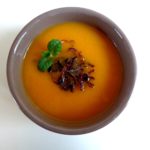 Soups
Soups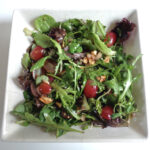 Salads
Salads
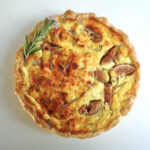
 Fish and shellfish
Fish and shellfish Poultry and game
Poultry and game Meat dishes
Meat dishes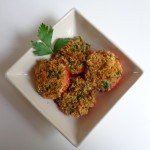 Vegetables
Vegetables Pasta and grains
Pasta and grains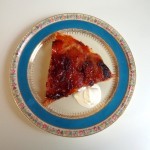
 What could be better when the temperature soars than a zingy cold soup? This one combines zucchini with tiny lentils, Indian flavorings and mint, and can be topped with coconut milk and/or any number of embellishments. The idea for it popped into my head as yet another heatwave loomed in Paris. With the mercury due to hit 100 degrees – that’s around 40 Celsius – I wanted to make something cool ahead of time…
What could be better when the temperature soars than a zingy cold soup? This one combines zucchini with tiny lentils, Indian flavorings and mint, and can be topped with coconut milk and/or any number of embellishments. The idea for it popped into my head as yet another heatwave loomed in Paris. With the mercury due to hit 100 degrees – that’s around 40 Celsius – I wanted to make something cool ahead of time… When summer strikes, it’s time to head to the market for red currants — or, if you’re lucky enough to have them in your garden, to go on a picking spree. These jewel-like berries make a fabulous jam that is remarkably easy to prepare. Unlike cherries, plums or apricots, red currants do not need pitting. And unlike red currant jelly, the jam does not require the tricky step of squeezing the cooked berries through a cheesecloth (étamine).
When summer strikes, it’s time to head to the market for red currants — or, if you’re lucky enough to have them in your garden, to go on a picking spree. These jewel-like berries make a fabulous jam that is remarkably easy to prepare. Unlike cherries, plums or apricots, red currants do not need pitting. And unlike red currant jelly, the jam does not require the tricky step of squeezing the cooked berries through a cheesecloth (étamine). In the good old days, when I still had my country cottage in Burgundy, I had both red and black currants growing in the garden in profusion. Every year there was a tense moment in early summer when the berries started to ripen. I could only get down to the cottage on weekends. Who would get the ripe berries first, me or the birds? Sometimes the birds won, but I usually managed to pick enough for a batch or two of jam. And once the jam is in the jars, you can keep it for months or years.
In the good old days, when I still had my country cottage in Burgundy, I had both red and black currants growing in the garden in profusion. Every year there was a tense moment in early summer when the berries started to ripen. I could only get down to the cottage on weekends. Who would get the ripe berries first, me or the birds? Sometimes the birds won, but I usually managed to pick enough for a batch or two of jam. And once the jam is in the jars, you can keep it for months or years. Jam is a different matter — easy to make, and so rewarding in the bleak midwinter when you open a jar and dip in a spoon. The intense burst of flavor as you taste the fruit will transport you back to blissful summer days. And you’ll have the satisfaction of knowing that you did it yourself. With just fruit and sugar.
Jam is a different matter — easy to make, and so rewarding in the bleak midwinter when you open a jar and dip in a spoon. The intense burst of flavor as you taste the fruit will transport you back to blissful summer days. And you’ll have the satisfaction of knowing that you did it yourself. With just fruit and sugar.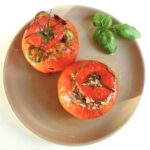 Stuffed tomatoes are one of the glories of French country cooking. This is peasant food at its finest, and fillings differ considerably. The traditional recipe, which hails from Provence, uses sausage meat, often in combination with beef or veal, and flavored with onion, garlic, herbes de Provence and fresh parsley or basil. In a lighter, vegetarian/vegan version, the tomatoes are stuffed with a filling similar to ratatouille, with a little bulghur added for heft.
Stuffed tomatoes are one of the glories of French country cooking. This is peasant food at its finest, and fillings differ considerably. The traditional recipe, which hails from Provence, uses sausage meat, often in combination with beef or veal, and flavored with onion, garlic, herbes de Provence and fresh parsley or basil. In a lighter, vegetarian/vegan version, the tomatoes are stuffed with a filling similar to ratatouille, with a little bulghur added for heft.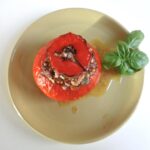 Fillings for tomatoes have evolved over the years in France. In the old days, leftover meat from boiled dishes such as
Fillings for tomatoes have evolved over the years in France. In the old days, leftover meat from boiled dishes such as 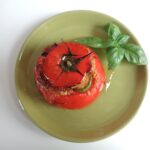 For the veggie filling, you can follow the recipe given here — with eggplant, zucchini, onions and garlic — or use your imagination. I’ve seen recipes that use combinations including potatoes, carrots, mushrooms, corn, pine nuts, raisins, goat cheese or olives. In all of these, the tomato pulp is also incorporated.
For the veggie filling, you can follow the recipe given here — with eggplant, zucchini, onions and garlic — or use your imagination. I’ve seen recipes that use combinations including potatoes, carrots, mushrooms, corn, pine nuts, raisins, goat cheese or olives. In all of these, the tomato pulp is also incorporated. If you’ve never experienced a raspberry soufflé, it’s like tasting warm, fluffy, raspberry-flavored air. Sweet, light and ephemeral. And the good news is that this elegant dessert is remarkably easy to make. I’m not an expert on dessert soufflés, but when I saw Michel Guérard, one of France’s most venerated chefs, whip up a couple of small raspberry soufflés during a television feature, I knew I had to try to make them myself. Instant success!
If you’ve never experienced a raspberry soufflé, it’s like tasting warm, fluffy, raspberry-flavored air. Sweet, light and ephemeral. And the good news is that this elegant dessert is remarkably easy to make. I’m not an expert on dessert soufflés, but when I saw Michel Guérard, one of France’s most venerated chefs, whip up a couple of small raspberry soufflés during a television feature, I knew I had to try to make them myself. Instant success! It’s only May and it’s already summer in the city in Paris — a great time to enjoy grilled pork brochettes with tomato, cucumber and red onion, even if you don’t have a barbecue. Today’s recipe adds a French twist to a Russian summertime favorite, shashlik. The secret is marinating the pork in — wait for it — red wine vinegar. I couldn’t believe this when a Russian friend first gave me the recipe. In France we mainly marinate in wine. But it works.
It’s only May and it’s already summer in the city in Paris — a great time to enjoy grilled pork brochettes with tomato, cucumber and red onion, even if you don’t have a barbecue. Today’s recipe adds a French twist to a Russian summertime favorite, shashlik. The secret is marinating the pork in — wait for it — red wine vinegar. I couldn’t believe this when a Russian friend first gave me the recipe. In France we mainly marinate in wine. But it works.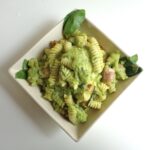 A culinary delight on a recent trip to Italy was an innovative pairing of twisty pasta and zucchini. This dish — the creation of my friend Gisella, a superlative cook — is not as simple as it sounds. The zucchini is cooked two ways so that the pasta is both bathed in a silky zucchini sauce and embellished with strips of sautéd zucchini. Grated parmesan, small squares of dry-cured ham and snipped fresh basil are added at the end.
A culinary delight on a recent trip to Italy was an innovative pairing of twisty pasta and zucchini. This dish — the creation of my friend Gisella, a superlative cook — is not as simple as it sounds. The zucchini is cooked two ways so that the pasta is both bathed in a silky zucchini sauce and embellished with strips of sautéd zucchini. Grated parmesan, small squares of dry-cured ham and snipped fresh basil are added at the end.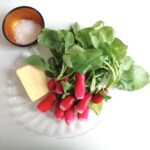 A quintessentially French dish that comes into its own in springtime is radis au beurre, or radishes with butter and salt. This traditional bistro fare makes a great start to a meal. I often serve radis au beurre at cocktail hour — fresher and much lighter than chips or nuts, especially if you go easy on the butter. Radis au beurre may also be served as a first course at the table, often accompanied by other back-to-the-land starters.
A quintessentially French dish that comes into its own in springtime is radis au beurre, or radishes with butter and salt. This traditional bistro fare makes a great start to a meal. I often serve radis au beurre at cocktail hour — fresher and much lighter than chips or nuts, especially if you go easy on the butter. Radis au beurre may also be served as a first course at the table, often accompanied by other back-to-the-land starters. One thing to note is that French radishes are rosy red with a white tip and elongated rather than round. They also tend to be less piquant than round varieties. (Strangely, they are referred to in English as ‘French breakfast radishes’, although I have never seen radishes served for breakfast over here.) No need to fret if you live elsewhere. Any red radishes would be fine for this dish.
One thing to note is that French radishes are rosy red with a white tip and elongated rather than round. They also tend to be less piquant than round varieties. (Strangely, they are referred to in English as ‘French breakfast radishes’, although I have never seen radishes served for breakfast over here.) No need to fret if you live elsewhere. Any red radishes would be fine for this dish. This dish of chicken in a creamy paprika sauce came about as a result of current events. I thought I’d like to make something Ukrainian in honor of a besieged nation, and I also wanted to add to the poultry dishes already on this site. My first idea, rather naturally, was chicken Kyiv (suprêmes de volaille à la Kyiv). But a little research showed that this dish, which by the way is quite complicated to make, is actually Russian in origin. Nyet.
This dish of chicken in a creamy paprika sauce came about as a result of current events. I thought I’d like to make something Ukrainian in honor of a besieged nation, and I also wanted to add to the poultry dishes already on this site. My first idea, rather naturally, was chicken Kyiv (suprêmes de volaille à la Kyiv). But a little research showed that this dish, which by the way is quite complicated to make, is actually Russian in origin. Nyet.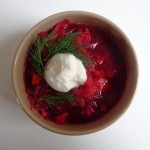 Grandma Anne was a good cook, although her imprecision with measurements drove my mother crazy. For example, her recipe for syrniki — little pancakes made with smooth cottage cheese and served with sour cream and jam — calls for ‘one half eggshell water’. I’d like to post this family recipe here one of these days, along with two more, Grandma Anne’s fabulous stuffed cabbages and her wonderful cheesecake.
Grandma Anne was a good cook, although her imprecision with measurements drove my mother crazy. For example, her recipe for syrniki — little pancakes made with smooth cottage cheese and served with sour cream and jam — calls for ‘one half eggshell water’. I’d like to post this family recipe here one of these days, along with two more, Grandma Anne’s fabulous stuffed cabbages and her wonderful cheesecake.  Meantime when thinking about today’s post I was surprised to realize that I’ve already posted two Ukrainian dishes on this site —
Meantime when thinking about today’s post I was surprised to realize that I’ve already posted two Ukrainian dishes on this site —  Happy cooking.
Happy cooking.

